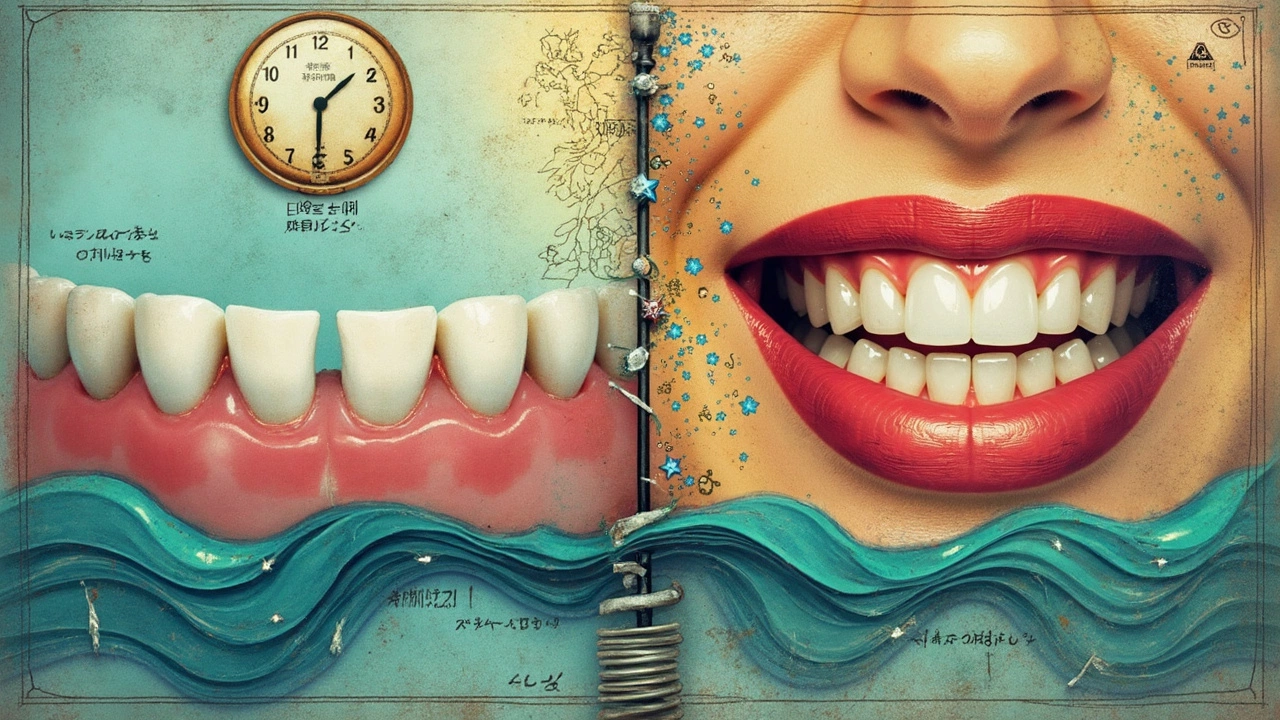So, you're considering dental implants in the UK and wondering, 'How long will I be going without teeth?' It's a pretty common question, and honestly, it's one of those things that can vary quite a bit from person to person. But don't worry, let's break down what usually happens.
After a tooth extraction, your gums need some healing time before the implants can be placed. This period can range anywhere from a few weeks to a few months. It's all about ensuring your mouth is ready for the new implant and ultimately, the dental crown that'll be attached.
Now, are you looking at an extended stint without teeth? Not necessarily. Temporary solutions are often available to bridge that gap. Think of partial dentures or temporary crowns that can maintain your look and function while you heal. More on that later!
And the good news? Advancements in implant technology have made the waiting game a whole lot more manageable than it used to be. With new techniques and materials, it’s quite a ride from toothless to beaming smiles.
- The Implant Timeline: What to Expect
- Healing Phases and Toothless Days
- Temporary Solutions While You Wait
- Essential Tips for a Smoother Process
- Modern Innovations in Dental Implants
The Implant Timeline: What to Expect
So, you've decided to go for dental implants UK. What's next? First thing, this isn't a one-day affair. It involves a few steps and a timeline that can stretch depending on your specific situation.
Step 1: Consultation
This is where your dentist takes a look at your overall health and oral situation. They'll do x-rays and maybe even a CT scan to get a clear picture of what's going on. This helps in determining the type and number of implants needed.
Step 2: Tooth Extraction
Time to say goodbye to any teeth that need removing. The extraction itself doesn't take much time, but the healing process is another story. It usually takes a few weeks for the gums to heal properly.
Step 3: Implant Placement
Once your gums have healed, it's time for the main event: inserting the implant. A small titanium post is placed into the jawbone, which acts as a replacement root. This step involves a bit of minor surgery, so expect some downtime afterward.
Step 4: Healing and Osseointegration
Here's where patience comes into play. Your jawbone will need time—typically 3 to 6 months—to fuse with the implant in a process called osseointegration. It's crucial for the stability of your implant.
Step 5: Abutment Placement
After osseointegration, an abutment is added on top of the implant. This acts as a connector between the implant and the final crown.
Step 6: Crown Placement
Finally, the moment you've been waiting for: your custom-made crown is attached. Now, you're good to go with your brand-new smile.
And if you're worried about spending too many days toothless, don't skip the
Healing Phases and Toothless Days
Alright, let’s get into the nitty-gritty of the healing period when getting dental implants UK. This stage is super important because a solid foundation is crucial for any good smile, right?
The Initial Days Post-Extraction
Once your tooth is extracted, the clock starts ticking on the healing process. Your gums might feel sore for a few days, but that’s just Mother Nature doing her job. Usually, it takes about 10 to 14 days for your gums to start feeling normal again.
Osseointegration: The Big Word That Matters
Now here’s the science-y bit: your jaw needs to mesh with the implant in a process called osseointegration. This can be the longest phase, stretching anywhere from 3 to 6 months. During this time, the implant becomes part of the jawline, paving the way for strong and stable teeth.
You might be wondering, 'Will I be up the creek without a paddle, tooth-wise?' Not entirely. Temporary solutions can swoop in to save the day until your mouth is ready for the permanent fixtures.
Managing Those Toothless Days
- Partial Dentures: Think of these as a temporary fix that can bridge the gap, letting you smile with confidence.
- Temporary Crowns: These are mostly for front teeth and can keep your grin intact.
- Diet Adjustments: Eating softer foods is a lifesaver during this phase. Soups, smoothies, and mashed potatoes will become your best buddies.
Sticking to your dentist’s advice during this period is key. It's not just about getting through the wait—it's about ensuring that the implant lasts and functions just like a natural tooth. So hang in there, you’re well on your way to a fabulous set of pearly whites!

Temporary Solutions While You Wait
Waiting for your dental implants can be a tad inconvenient, but rest assured, there's no need to lose your smile along the way. There are a few options to fill the gap and maintain function while you're healing.
Partial Dentures
One of the most common solutions is partial dentures. These are removable and designed to fit snugly over the gums where the missing teeth used to be. They're a quick fix and can usually be made and fitted quite speedily, allowing you to carry on with confidence.
Flipper Teeth
In the same league as partial dentures, we have flipper teeth. These are temporary tooth replacements that are also removable and designed for short-term use. They're lightweight and typically cheaper, offering a convenient option while your gums are recuperating.
Temporary Crowns
If there's enough tooth structure left, sometimes a temporary crown can be used. These are especially handy if your situation doesn't involve entire tooth extraction but more like a compromised aesthetic area. They look pretty natural, so most people won't even notice you're wearing one.
Bridge Work
For those who prefer something fixed, temporary bridges are an effective solution. They literally bridge the gap between missing teeth and can make eating and smiling easier without the worry of anything slipping.
| Solution | Duration | Cost Range (£) |
|---|---|---|
| Partial Dentures | Weeks to Months | 200 - 600 |
| Flipper Teeth | Weeks to Months | 150 - 400 |
| Temporary Crowns | Weeks to Months | 100 - 300 |
| Bridge Work | Months | 400 - 800 |
Everyone's situation is a bit different, so chatting with your dentist about which temporary option suits you best is key. This way, you'll not only tackle the implant process smoothly but also keep smiling without missing a beat!
Essential Tips for a Smoother Process
Getting dental implants UK can be quite the journey, but it doesn't have to be a rough one. The trick is knowing a few key tips to make this process more manageable. These insights can save you time, discomfort, and perhaps even a bit of cash.
1. Consult a Skilled Dental Practitioner
Your choice of dentist is crucial. Make sure they have a solid track record with implants. Ask about their previous cases and success rates. You want someone who knows the ins and outs of the implant placement process.
2. Follow Pre-Operative Guidelines
If your dentist gives you tips, like not smoking or avoiding certain medications before the procedure, listen up. These guidelines can significantly impact healing.
3. Prioritize Oral Hygiene
Keeping your mouth clean is vital, especially when healing. Brush and floss regularly, and don't skip that extra mouthwash rinse. It can fend off infections that might delay your implant process.
4. Plan for Your Temporary Solutions
Discuss temporary options like partial dentures or temporary crowns with your dentist before you start. Planning ahead means you're not caught off-guard during that toothless period.
- Partial Dentures: They'll keep you smiling while your gums heal.
- Temporary Crowns: These can be a great cosmetic fix until your permanent ones are ready.
5. Be Patient and Stay Positive
The healing phase varies, and sometimes it takes a little longer. Keep a positive mindset, and remember, good things take time!
| Healing Timeline | Average Duration |
|---|---|
| Initial Healing | 2-3 weeks |
| Bone Integration | 3-6 months |
A little patience and planning go a long way in smoothing out the bumps in the tooth implant timeline. Remember, each step is a stride closer to that perfect smile!

Modern Innovations in Dental Implants
Great news for those pondering dental implants UK—recent innovations have made the process simpler and more efficient than ever. The field has seen some pretty impressive leaps that help reduce the 'toothless time' and improve overall experience.
One exciting development is immediate load implants, often called 'same-day implants.' As the name suggests, this technique allows the placement of a temporary crown on the implant right after it's inserted. This means you're not going without teeth, even temporarily. However, it's not a one-size-fits-all; your jawbone health and implant site stability are crucial factors.
Digital Planning and Precision
Digital technology has entered the scene in a big way. Using 3D imaging and advanced software, dentists can plan the implant placement with incredible precision. This ensures a perfect fit and reduces the risk of complications. According to Dr. Emily Langford, a leading implant specialist,
"Digital planning has transformed our approach, allowing us to tailor each implant procedure to the individual's unique anatomy, ensuring both accuracy and success."
Materials that Matter
Another big step forward is in the materials used. Zirconia implants are gaining popularity as they offer a metal-free alternative that's durable and biologically friendly. They also provide a more natural look, especially in the front teeth.
Moreover, titanium has been the go-to for years because of its strength and compatibility with the body. New titanium alloys are in the works, promising even better integration and a longer lifespan for your implants.
Minimally Invasive Techniques
It's all about making the process easier on you. Minimally invasive techniques, like keyhole surgery, have emerged, offering less discomfort and faster recovery times. It means smaller incisions, reducing healing time and speeding up your journey to a full smile.
Overall, these innovations point to a bright future for dental implants, with more options and enhanced comfort—making the idea of getting an implant way less daunting for folks across the UK.




